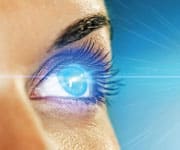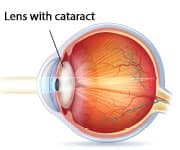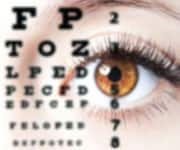Carnosine, Cataracts, and Visual Clarity

Cataracts cause about half of all cases of blindness worldwide.1,2
By age 80, more than half of all Americans will have cataracts, or will have undergone surgery to remove them.3
Researchers have been investigating two different but related forms of the nutrient carnosine to help slow the development of cataracts as well as improve visual performance of cataract-affected eyes.
A new study illustrates the ability of oral carnosine in capsule form to preserve normal structure of proteins in the lens of the eye—an action that may slow or prevent the development of vision-impairing cataracts.4
The study shows that carnosine works through several interrelated mechanisms that help protect against the underlying changes caused by aging that lead to cataracts.4
In addition, human studies have found that a derivative of carnosine, N-acetylcarnosine, when used as an eye drop, can induce improvements in visual performance of cataract-affected eyes.5,6
Many readers of this magazine have been using a high-potency carnosine supplement (500-1,000 mg/day) since we introduced it in 2000.
A number of others also use eye drops that deliver N-acetylcarnosine directly to the eye lens where cataracts occur.
Based on both established and recent science, there is now a two-part strategy of using both carnosine and N-acetylcarnosine to help reduce the risk of cataracts.
Eye Lens Protector
Cataracts are cloudy spots in the otherwise crystal-clear lens of the eye that are formed when lens tissues break down, or when lens proteins clump together.4,7 They cause blurred vision, a faded appearance of colors, and increased sensitivity to glare and bright lights.7
Cataracts were once thought to be an inevitable consequence of aging. Today, we recognize that cataracts have several interrelated causes.
That makes a multitargeted nutrient like carnosine attractive for fighting the structural defects that manifest clinically as vision-robbing cataracts.8
Carnosine is a combination of two amino acids, alanine and histidine. Your body makes some of its own carnosine. It is found in higher concentrations in muscle, the brain—and in lenses of the eyes.9-12
A dietary source of carnosine is red meat, something that many health-conscious people seek to reduce or avoid altogether. Even red-meat eaters, however, only have protective carnosine levels part of the day. That’s because the amount of carnosine in meat is rapidly degraded by carnosinase enzymes in your body.13
Scientists are discovering that the use of oral and topical forms of carnosine can help reduce the risk of cataracts.
As you’ll read next, carnosine possesses unique mechanisms that guard against structural changes that lead to cataract formation.14-17
What You Need to Know
 |
Carnosine May Help Prevent Cataracts
- Cataracts, which are cloudy collections of misfolded protein molecules that accumulate in the lens, are a leading cause of vision loss and blindness in older adults.
- Among the primary underlying causes of cataracts are oxidative stress and glycation of the delicate proteins that naturally maintain the lens in a state of crystalline clarity.
- Carnosine has potent anti-glycation and free radical-reducing properties.
- A new study sheds light on mechanisms by which carnosine protects lens proteins to prevent cataracts and their progression.
- Human, animal, and lab studies show that carnosine, unlike any medication, can not only prevent the protein damage that produces cataracts, but is also capable of reversing them, leading to the possibility of the first therapy to slow cataract progression.
How Oral Carnosine Prevents Cataracts
As we age, the cumulative impact of oxidant stress and protein degradation18-29 distorts our delicate eye lenses—and helps explain the increase in cataracts.
A factor for the development of age-related cataracts is protein misfolding and clumping—hallmarks of cataract formation.29
A new laboratory study shows that carnosine works through several mechanisms that help protect against cataracts.
The researchers discovered the following new findings:4
• The presence of carnosine largely prevented the accumulation of distorted and dysfunctional lens proteins.
• Carnosine achieved these effects in part by restoring the protective function of the lens protein, alpha-crystallin. These crystallins are present at high concentrations in the eye lens, and preserving their proper structure and arrangement is an important factor in keeping the lens clear.
Carnosine reduced lens protein instability and breakdown. Ultimately—and most importantly—carnosine prevented the development of lens cloudiness, the ultimate outcome of cataracts.
This new scientific study hails the multitargeted functions of carnosine, and suggests new mechanisms by which carnosine may prevent glycation- and oxidative stress-related cataract formation.4
Cataracts, Glycation, and Carnosine

Glycation is one of the underlying causes of cataracts.29 It is also one of the basic processes (along with oxidative stress, mitochondrial dysfunction, and DNA damage) that hastens the aging process in all cells, tissues, and organs.27,28
Diabetes is the classic example of the adverse impact of glycation. Diabetes is a grimly accurate model of accelerated aging.30-33 People with diabetes suffer from the features associated with normal aging, but at a much faster rate than seen in nondiabetic individuals.
One of the common denominators for diabetes and normal aging is the glycation of proteins and the resulting deterioration of their function.27 This means that fighting glycation everywhere in the body is a direct and important way to decelerate aging.
Perhaps nowhere is the impact of glycation on accelerated aging as apparent as it is in the eye lens, the normally crystal-clear portal that focuses light on the retina.29
Glycation of lens proteins occurs in both diabetic and nondiabetic people, although diabetics experience cataracts much earlier than nondiabetics.19-27
Carnosine is a potent antiglycation agent and oxidative-stress reducer. One animal study of cataracts showed its ability to reduce levels of glycated lens proteins, prevent the loss of protective enzymes, and, ultimately, to delay the clouding of the lens.17
One important laboratory study showed that carnosine prevented the lens protein crystallin from clumping together into dense, opaque fibrils. Carnosine was then found to simultaneously restore crystallin’s ability to positively impact other proteins and prevent them from clumping together.15
Even more promising, carnosine has now been shown to disassemble those dense opaque clumps of crystallin, thereby restoring lens transparency in animal lenses in culture.15
It is important to note that some of the studies presented here discuss the well-known antiglycation properties of oral carnosine supplementation in cataract prevention.
As you are about to learn, topical application of a derivative form of carnosine called N-acetylcarnosine has been shown to penetrate the lens of the eye and help maintain more youthful structural eye lens clarity.
How Cataracts are Formed
 |
In order to understand why carnosine is so beneficial, it’s helpful to understand how cataracts form to begin with.
Cataracts are opaque collections of deformed proteins that accumulate within the clear lens of the eye.4,36
All proteins rely closely on their exquisitely-folded molecular structure for their function. Misfolded proteins don’t work properly, and misfolded lens proteins become opaque and unable to transmit light, thereby forming a cataract.37,38
An important factor in protein misfolding in the lens is nonenzymatic glycation. In this process, sugars become chemically bound to amino acids, proteins, and other essential biomolecules, distorting their structure, which contributes to protein misfolding.4,39-42
Specialized “chaperone” proteins called crystallins normally help prevent protein unfolding in the lens. But when crystallins themselves undergo glycation, they lose this protective function. This essentially removes the last line of defense, and allows cataracts to form even faster.23,38,40,41
The most recent study of carnosine in cataracts shows us that, by slowing glycation-induced unfolding of lens proteins, carnosine can help prevent cataract formation.4
Human Studies on N-Acetylcarnosine Eye Drops
As we have seen, carnosine can play an important role as it relates to normal structural changes that occur in the eye over time. When carnosine is applied as an eye drop, it can benefit the surface cornea, but does not penetrate the eye lens.
N-acetylcarnosine, however, can penetrate the front chamber of the eye and subsequently undergo conversion into carnosine.34 N-acetylcarnosine eye drops may thus be a useful delivery vehicle to boost carnosine levels beyond the cornea into the front chamber of the eye and the eye lens.
Human studies have demonstrated that N-acetyl-carnosine 1% eye drops lead to improvements in cataracts and visual performance of cataract-affected eyes.5,6
Specifically, the studies demonstrated improvement in overall light transmission, glare sensitivity, and, most importantly, visual sharpness.5,6
Improvements in glare sensitivity are particularly relevant for older adults who drive. Glare sensitivity can be very dangerous because it produces the characteristic halos around bright lights, which can confuse drivers and contribute to accidents.
One study showed that N-acetylcarnosine 1% eye drops given to older drivers improved visual clarity and reduced glare sensitivity at red and green targets.35 For best results, use carnosine as early as possible, since its specialty lies in preventing, rather than treating, cataracts.
Understanding Cataracts
 |
Cataracts are among the most common visual disorders, causing about half of all cases of blindness worldwide.1,2
There are many risk factors for cataracts, including diabetes, smoking, alcohol, and sunlight exposure.3 Glycation plays an important role in the development of cataracts. Studies show that reducing or reversing glycation with oral carnosine and topical N-acetylcarnosine eye drops can slow cataract formation.4,8,17,43-46
Symptoms of cataracts include blurred vision, a faded appearance of colors, increased sensitivity to glare and bright lights, and diminished night vision.3
As a result, many cataract sufferers have trouble with basic visual functions such as driving, reading, or recognizing faces.47 Additionally, there is now evidence that cataract-induced vision problems can increase the risk of depression and even of falling in older people.48
Anyone who is experiencing these symptoms should see their physician or optometrist for an eye examination, which is the only way of diagnosing cataracts.3
Summary

By age 80, a majority of Americans will have cataracts or have undergone cataract surgery.
Cataracts are dull, opaque collections of misfolded proteins that accumulate within the lens of the eye, blocking light and blurring vision.
Protein glycation is a destructive process involved in the production of the dense protein clumps that form cataracts. This has led to an explosion of interest in bioactive molecules capable of preventing or even reversing glycation in an effort to preserve clear vision into our advanced years.
Carnosine has now been shown to preserve the proper structure and arrangement of lens proteins, preventing loss of lens crystallinity under laboratory and real-world conditions. One of the main ways it accomplishes this is through its ability to fight glycation, which is a critical factor in cataract formation.
N-acetylcarnosine has long been used as a 1% stabilizing agent in eye drops that contain FDA-approved lubricating agents.
A number of people use these eye drops daily for their multifaceted benefits.
To maintain continuous carnosine blood levels, take a supplement that provides 500 mg of carnosine twice daily.
The reason it’s important to take 500 mg of oral carnosine twice a day is that carnosinase enzymes degrade even higher-potency (500 mg) carnosine within 12 hours of ingestion.13
For the past 18 years, many readers of this publication have been using high-potency carnosine oral supplements and lubricating eye drops containing N-acetylcarnosine.


Social Login